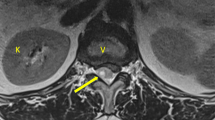Summary
The spontaneous spinal epidural haematoma (SSEH) is a rarity, but the severe and permanent motor disability underlines its importance.
From 1957 seven cases of SSEH have been diagnosed and operated on in the National Institute of Neurosurgery, Budapest. These cases are analysed and discussed.
The clinical picture began with local pain of the spine and radicular signs but some hours or days later paraparesis or paraplegia and incontinence developed. In the discussed cases the neurological deficit progressed to complete para- or tetraplegia in 5 cases. Only 2 patients had partial spinal transverse lesions on admission. All patients underwent myelography to detect the spinal space occupying lesion and were operated on soon. Three patients recovered completely, 2 remained partly and 2 totally paralysed.
The outcome depended mainly on the timing of neurological deficiency. If the neurological signs existed less than 8 hours the patients recovered completely or fairly well while the prognosis was poor if the transverse lesion persisted longer than 24 hours.
The authors stress the importance of correct and fast decisions at the first medical examination for the outcome of this disease, because only immediate transfer to a neurosurgical department gives a chance of good recovery.
Similar content being viewed by others
References
Anderson TJ, Donaldson I MacG (1989) Spontaneous resolution of cervical spinal epidural haematoma. Postgrad Med J 65: 488–490
Beatty RM, Winston KR (1984) Spontaneous cervical epidural haematoma. J Neurosurg 61: 143–148
Foo D, Rossier AB (1981) Preoperative neurological status in predicting surgical outcome of spinal epidural haematomas. Surg Neurol 15: 389–401
Grollmus F, Hoff J (1975) Spontaneous spinal epidural haemorrhage: good results after early treatment. J Neurol Neurosurg Psychiatry 38: 89–90
Hissa E, Boumphrey F, Bay J (1986) Spinal epidural haematoma and ankylosing spondylitis. Clin Orthop (208): 225–227
Jackson R (1869) Case of spinal apoplexy. Lancet 2: 5–6
Klossek von H, Hüller E (1984) Zur Problematik der spontanen spinalen Epiduralhaematome. Zbl Neurochir 45: 116–123
Mattle H, Sieb JP, Rohner M, Mumenthaler M (1987) Nontraumatic spinal epidural and subdural haematomas. Neurology 37: 1351–1356
Müller H, Schramm J, Roggendorf W, Brock M (1982) Vascular malformations as a cause of spontaneous spinal epidural haematoma. Acta Neurochir (Wien) 62: 297–305
Solymosi L, Wappelschmidt J (1985) A new neuroradiologic method for therapy of spinal epidural haematomas. Neurorad 27: 67–69
Zabala AB, Gonzales MG, Allut AG, Rumbo RM (1988) Spontaneous spinal epidural haematoma diagnosed by MRI. J Neurosurg Sci 32: 153–155
Author information
Authors and Affiliations
Rights and permissions
About this article
Cite this article
Major, O., Sipos, L., Czirják, S. et al. Spontaneous spinal epidural haematomas. Acta neurochir 111, 40–42 (1991). https://doi.org/10.1007/BF01402511
Issue Date:
DOI: https://doi.org/10.1007/BF01402511




